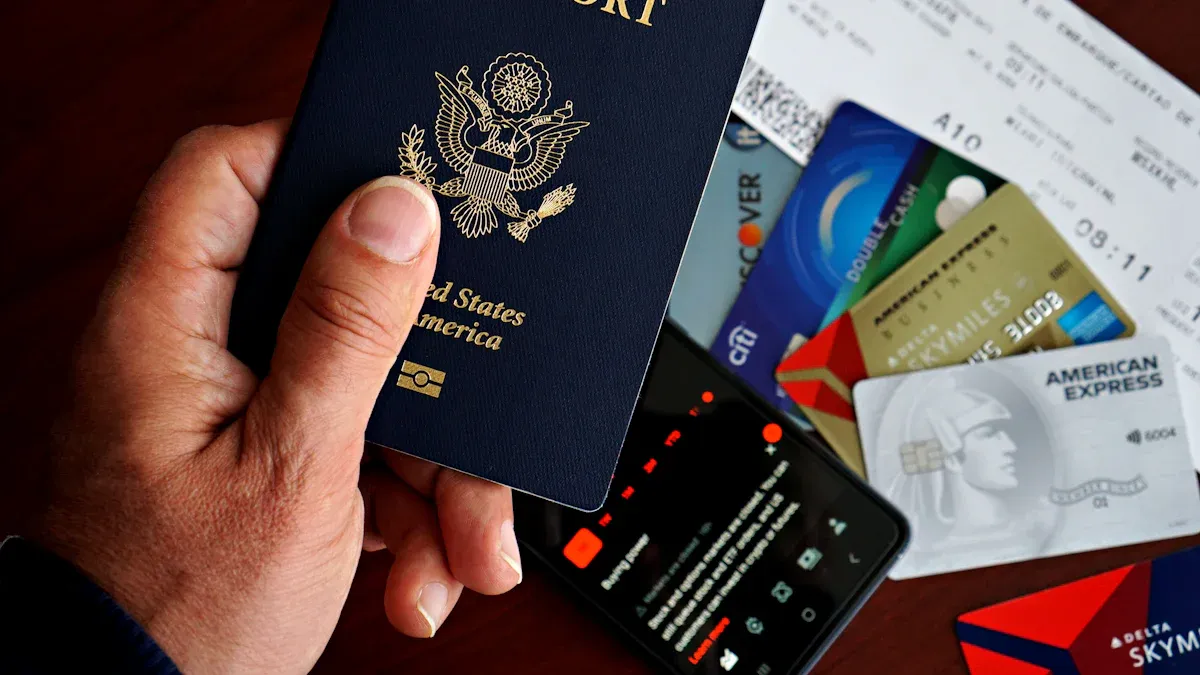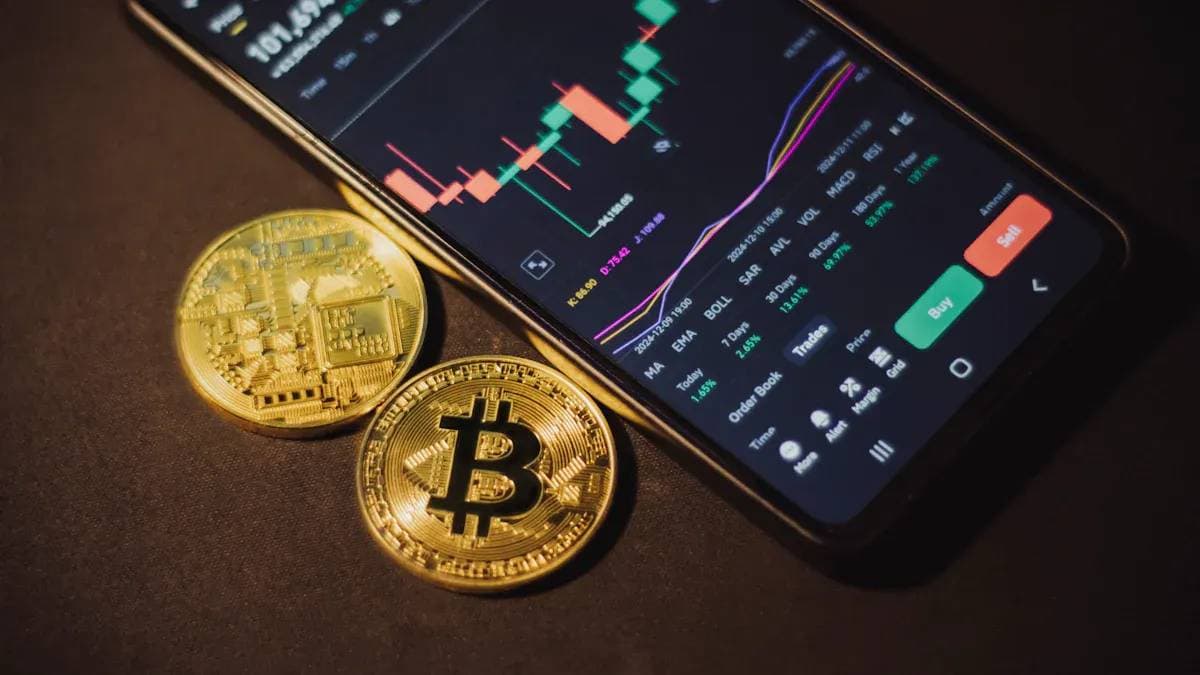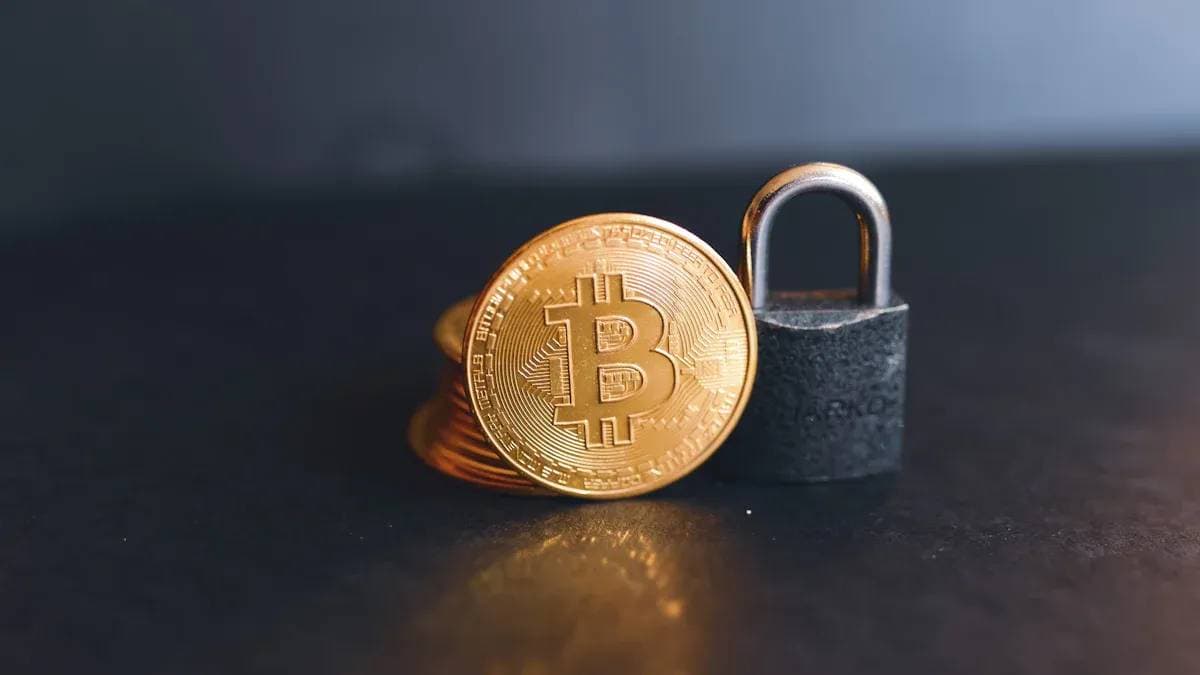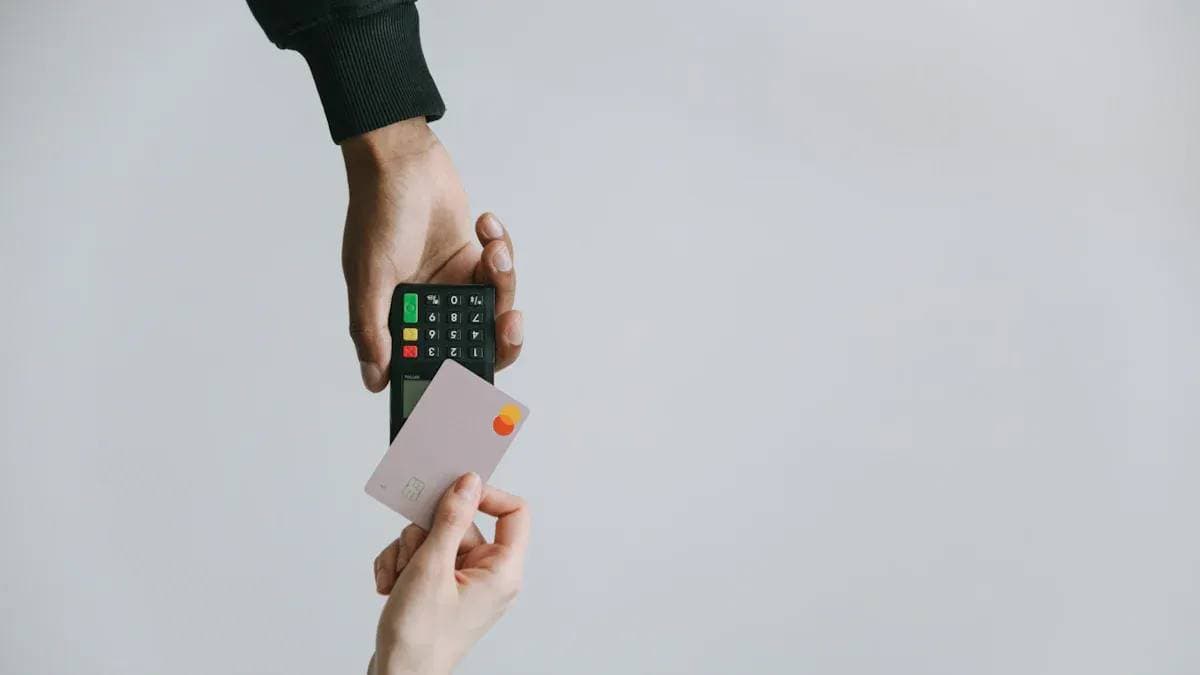- EasyCard
- Trade
- Help
- Announcement
- Academy
- SWIFT Code
- Iban Number
- Referral
- Customer Service
- Blog
- Creator
Beyond Traditional Banking: How USDT Completely Changes the Rules of Cross-Border Fund Flows

Image Source: unsplash
Have you ever been frustrated by traditional bank wire transfers? A single remittance may not only require waiting three to five business days, but it could also cost you up to $50. USDT offers a disruptive solution. You simply convert fiat currency to USDT, send it to the recipient’s wallet address, and the recipient can quickly cash it out. This path completely bypasses bank clearing networks, helping you achieve instant cross-border fund flows.
Did you know? USDT’s daily trading volume often exceeds $170 billion, and its massive market size ensures high liquidity, making the conversion process more convenient.
Core Highlights
- USDT makes cross-border transfers faster and cheaper than traditional bank wire transfers, with greater convenience.
- To transfer with USDT, you need to purchase USDT first, then send it to the recipient, and finally, the recipient converts the USDT to local currency.
- When transferring USDT, be sure to select the correct blockchain network and carefully verify the recipient’s address, as transfers cannot be reversed once completed.
- Choosing a safe and reliable trading platform is important, and you must understand and comply with local laws and tax regulations regarding cryptocurrencies.
USDT’s Core Advantages: Speed, Cost, and Convenience

Image Source: unsplash
When you choose USDT, you are actually selecting a completely new paradigm for fund flows. It fundamentally challenges the traditional banking system in terms of speed, cost, and convenience.
Speed Advantage: From Days to Minutes
Traditional bank cross-border wire transfers rely on the SWIFT system. Your funds need to go through clearing by multiple correspondent banks and are strictly limited by bank business days and operating hours. This means that a remittance initiated on a Friday afternoon may not arrive until the following Tuesday or even later.
USDT is completely different. It operates on blockchain networks that work 24/7. This means that whether on weekends or holidays, your transfer instructions can be processed immediately.
Speed Comparison Overview
The table below clearly shows the huge difference in speed between USDT and traditional bank wire transfers:
Attribute USDT (using TRC-20 network as an example) Bank Wire Transfer Arrival Time Usually within minutes 1-5 business days Availability 24/7/365, uninterrupted Limited by business days and time zones Settlement Mechanism Blockchain network instant confirmation Requires clearing by multiple banks
This near-real-time settlement speed provides you with unprecedented flexibility, making urgent fund needs no longer a problem.
Cost Advantage: Say Goodbye to High Fees
The cost structure of traditional wire transfers is complex and opaque. A single remittance not only includes the wire transfer fee charged by the sending bank but may also involve fees from 1-2 intermediary banks, as well as potential incoming fees charged by the receiving bank. Additionally, banks typically use exchange rates with markups for currency conversion, which is another hidden cost.
Let’s take a $1,000 remittance as an example to intuitively compare costs:
- Traditional Bank Wire Transfer:
- USDT Transfer (using TRC-20 network as an example):
- You only need to pay the blockchain network’s “Gas fee.” This fee is unrelated to the transfer amount, whether $1,000 or $100,000, the fee is basically the same.
- Total Estimated Cost: Usually between $1 - $2
Note: USDT’s cost advantage lies in the transfer process itself. When you buy or sell USDT on an exchange, the platform charges a small trading fee, but even so, the total cost is usually far lower than traditional wire transfers.
Convenience Advantage: Global Access with One Phone
Have you ever thought that making an international remittance could be as simple as sending a message? USDT makes this a reality. You no longer need to fill out complex wire transfer forms or have a traditional bank account.
You only need:
- A smartphone with internet access.
- A cryptocurrency wallet app.
Through the wallet app, you can directly send USDT to the recipient’s wallet address. The entire process is point-to-point, eliminating all intermediaries. This not only simplifies operations but, more importantly, opens the door to financial services for over 1.7 billion unbanked adults worldwide, truly achieving financial inclusion.
Empowering Businesses: Optimizing Global Commercial Payments
USDT’s advantages are not limited to individual users; they are also bringing profound changes to global businesses, especially small and medium-sized enterprises. Businesses using USDT can:
- Accelerate fund turnover: When paying global suppliers or freelancers, USDT’s near-instant settlement characteristic shortens fund in-transit time from days to minutes. This greatly improves enterprise cash flow management, allowing working capital to be reinvested in production faster.
- Reduce operating costs: Businesses can bypass high bank wire transfer fees and currency conversion costs. For companies that frequently make small cross-border payments, the savings are considerable.
- Simplify payroll: For companies with international teams, USDT provides a unified payment layer. No matter where employees are located, the company can pay them on the same day at extremely low cost, enhancing employee satisfaction and financial efficiency.
Real Case:A software company in Turkey, CodeXperience, uses USDT to pay its international contractors. Previously, they suffered from local currency fluctuations and high bank fees. After switching to USDT, the company not only significantly reduced costs but also achieved instant cross-border fund flows, and contractors prefer this cooperation method due to fast receipt and easy cash-out. This fully demonstrates USDT’s huge potential in optimizing global commercial payments, helping enterprises achieve efficient instant cross-border fund flows.
USDT in Practice: Three Steps to Achieve Instant Cross-Border Fund Flows
You have mastered the theoretical knowledge; now let’s move to the practical phase. You will find that completing a cross-border remittance with USDT is far simpler than imagined. You only need to follow the following three core steps to easily master this powerful financial tool and achieve true instant cross-border fund flows.
Step One: Acquire USDT
Before sending USDT, you first need to convert your fiat currency (such as USD) to USDT. The most mainstream and convenient way is through the C2C/P2P (Customer-to-Customer / Peer-to-Peer) trading section of a compliant cryptocurrency exchange.
You can think of the P2P trading section as a large online marketplace. In this marketplace, many “merchants” post ads willing to exchange USDT for your fiat currency. You can choose the most suitable one based on exchange rate, payment method, and merchant reputation.
Overview of Mainstream P2P Trading Platforms
Many large exchanges offer P2P services, such as Binance as the world’s largest exchange, whose P2P market supports over 100 fiat currencies and 800 payment methods. The following is a comparison of some mainstream platforms:
Exchange Supported Assets Payment Methods Trading Fees Binance P2P BTC, ETH, USDT, FDUSD, DAI, etc. 800+ (100+ fiat) Zero fees for buyers KuCoin P2P BTC, ETH, KCS, USDT, USDC 100+ (30+ fiat) Zero fees for all trades LocalCoinSwap BTC, ETH, USDT, USDC, DAI, etc. 300+ (160+ fiat) Zero fees for deposits
In comprehensive digital wallet apps like Biyapay, you can usually find similar P2P trading functions, allowing you to complete purchases and transfers within one platform.
Safe Trading Tips: How to Screen Reliable Merchants?
The security of P2P trading is crucial. When selecting a trading counterpart, be sure to follow these principles:
- Check reputation: Prioritize merchants certified by the platform, with high transaction completion rates (usually recommended above 98%) and many positive reviews.
- Use platform escrow service: During trading, the platform temporarily “holds” the merchant’s USDT. Only after you pay and the merchant confirms will the platform release the USDT to you. Never conduct private transactions off-platform.
- Confirm receipt: Before marking “I have paid,” ensure you have successfully transferred the funds to the merchant via your chosen payment method (such as bank transfer).
- Beware of scams: Be vigilant against quotes far below the market average, as this may be scam bait.
Step Two: Execute the Transfer
Once you have USDT, the next step is to send it to the recipient. This process is as simple as sending an email, but there are a few key details you need to pay special attention to.
1. Choose the correct blockchain network
USDT exists on multiple blockchain networks, the most common being ERC-20 (Ethereum), TRC-20 (Tron), and BEP-20 (Binance Smart Chain). Choosing different networks results in vastly different transfer speeds and fees.
| Network | Transaction Fee | Transaction Speed | Applicable Scenarios |
|---|---|---|---|
| TRC-20 (Tron) | Extremely low (usually below $2) | Very fast (seconds to minutes) | Most cost-effective, suitable for most daily transfers |
| ERC-20 (Ethereum) | Higher (may range from $5 to $20+) | Slower, easily affected by network congestion | Mainly for interacting with Ethereum ecosystem DeFi apps |
| BEP-20 (BNB Chain) | Lower (usually below $0.1) | Faster (seconds) | Frequently used within the Binance ecosystem |
Important Reminder: Before transferring, you must confirm with the recipient that both parties select exactly the same network. If your USDT is on the TRC-20 network, it must be sent to the recipient’s TRC-20 address. Choosing the wrong network will result in permanent fund loss.
2. Copy and verify the wallet address
The wallet address is a long string of characters consisting of letters and numbers, the sole credential for receiving funds.
Warning: Transfers are irreversible!
Once a blockchain transfer is successful, it cannot be canceled or recovered. An address entry error, even a single character difference, will cause your funds to disappear forever. Be sure to follow these steps:
- Copy and paste: Never manually enter the address. Have the recipient provide the address directly, use the “copy” function, and paste it into your wallet’s (such as Biyapay) send field.
- Carefully verify: After pasting, carefully check the first few and last few characters of the address to ensure they match what the recipient provided. If possible, confirm again through a second channel (such as voice call).
- Conduct testing: If you are making a large transfer, strongly recommend testing with a very small amount (e.g., $1 USDT) first. Proceed with the large transfer only after the recipient confirms receipt.
3. Set reasonable Gas fees
Gas fees are “tips” paid to blockchain network miners or validators to process your transaction. Most wallets automatically set a reasonable fee for you. When the network is not congested, the default setting is fine. If the network is busy, you may need to slightly increase the Gas fee to ensure your transaction is prioritized, thereby guaranteeing instant cross-border fund flows.
Step Three: Recipient Cash-Out
When your friend or business partner receives USDT, they also need to convert it to local fiat currency, such as Mexican pesos, Thai baht, or Hong Kong dollars. This process is the reverse of purchasing USDT.
The recipient can follow these steps:
- Register an exchange account: Register an account on a local exchange that supports P2P trading (such as Binance, KuCoin, etc.).
- Post a sell ad: In the P2P trading section, they can create a “sell USDT” ad, setting the amount they want to sell, price, and preferred payment methods (such as local bank transfer, mobile payment, etc.).
- Wait for buyers: Local buyers will see this ad and pay local fiat to the recipient’s bank account as instructed.
- Confirm receipt and release USDT: After the recipient confirms receipt in their bank account, they click “confirm receipt” on the exchange platform, and the platform releases the escrowed USDT to the buyer. The transaction is complete.
More Flexible Conversion Options
In addition to direct conversion to fiat, the USDT ecosystem offers more choices. For example, in Mexico, recipients can use services like TransFi to instantly convert received USDT to a stablecoin pegged to the Mexican peso (MXN stablecoin) or settle directly to their Mexican bank account, further simplifying the process.
Through these three steps, you complete a full, efficient, and low-cost global fund transfer.
Risks and Compliance: Essential Knowledge for Safely Using USDT

Image Source: pexels
USDT opens the door to efficient, low-cost global fund flows for you, but this freedom also comes with responsibility. While enjoying convenience, you must clearly recognize and avoid potential risks. This concerns not only your fund security but also your legal compliance.
Operational Risks: Transfers Are Irreversible
This is the first iron rule you must remember when using USDT. Unlike bank transfers, once a transaction on the blockchain is confirmed, it cannot be canceled or recovered.
Warning: One mistake can lead to eternal regret!
Any small error on your part may result in permanent fund loss. For example:
- Wrong network selected: You mistakenly send USDT based on the Ethereum network (ERC-20) to an address that only supports the Tron network (TRC-20).
- Address error: You add or miss a character when copying and pasting, or fall for an “address poisoning” trap, sending funds to a scammer.
To avoid such tragedies, you must develop good operational habits. The most effective method is small-amount testing. Before sending large funds, test with a very small amount (e.g., $5 USDT). This small amount can help you confirm:
- The recipient address is accurate.
- The blockchain network you selected is correct.
- The entire process runs smoothly, giving you confidence for subsequent large transfers.
Platform Risks: Choose Reliable Exchanges
Your USDT is usually stored on exchanges or wallets, so the platform’s security directly determines your asset safety. The history of the cryptocurrency industry is full of cases of exchanges being hacked or suddenly closing.
| Exchange Name | Stolen Amount (USD) | Occurrence Time | Remarks |
|---|---|---|---|
| Mt. Gox | 460 million | 2014 | Led to exchange bankruptcy; users have not received full compensation to date. |
| Coincheck | 534 million | January 2018 | One of the largest cryptocurrency attacks in history at the time. |
| FTX | 477 million | November 2022 | Hacking occurred after exchange collapse, causing industry shock. |
| DMM Bitcoin | 308 million | May 2024 | Led to the company eventually shutting down operations. |
These events remind you that choosing a safe and reliable platform is crucial. You should prioritize exchanges that provide top-tier security guarantees, which typically have the following features:
- Two-factor authentication (2FA): In addition to passwords, phone verification codes or biometrics are required for login and withdrawal.
- Cold wallet storage: Most user funds are stored offline in cold wallets, effectively resisting online hacker attacks.
- Withdrawal whitelist: Allows you to preset trusted withdrawal addresses to prevent funds from being transferred to unknown addresses.
Compliance Risks: Comply with Local Regulations
When using USDT for cross-border fund flows, you must understand and comply with the laws and regulations of your jurisdiction. Global regulatory policies on cryptocurrencies vary widely.
- In mainland China, regulatory authorities prohibit cryptocurrency-related trading activities.
- In the United States, tax and securities laws have clear regulations on cryptocurrency transactions.
- In the European Union, the unified Markets in Crypto-Assets (MiCA) regulation is being gradually implemented.
This means you need to proactively understand two key issues:
- Legality of transactions: Does your region allow individuals to hold and trade cryptocurrencies? Is buying and selling USDT through P2P or other methods legally risky? Participating in non-compliant “underground trading” may involve you in money laundering or other illegal activities.
- Tax reporting: Many countries treat cryptocurrencies as assets. When you profit from trading USDT, you may need to report and pay capital gains tax to tax authorities. Ignoring tax obligations may lead to fines or even more serious legal consequences.
USDT provides you with a highly efficient, low-cost global fund flow new paradigm. Its disruptiveness lies in returning financial autonomy to you and your business. Of course, it is not perfect, and operational and compliance risks always exist. But as long as you master the correct methods and stay vigilant, this tool, regarded as a “new upgraded payment technology,” can become a powerful and flexible supplement outside traditional banking, making global fund flows truly “close as neighbors”.
FAQ
Is USDT legal?
The legal status of USDT varies by country and region. You must understand and comply with the laws in your area. For example, in mainland China, regulatory authorities prohibit cryptocurrency-related transactions. In many other regions, holding and trading USDT is legal as long as you comply with anti-money laundering (AML) and tax regulations.
What is the difference between USDT and Bitcoin?
You can think of USDT as a digitized USD, pegged 1:1 to the dollar, a stablecoin. Its main functions are value storage and payment. Bitcoin is an independent cryptocurrency without physical asset backing, with highly volatile prices, more like a speculative asset.
Why is the TRC-20 network more commonly used?
When conducting daily transfers, you will find the TRC-20 network (Tron chain) very popular. Its main advantages are extremely low transfer fees (usually below $2) and fast speed. In contrast, the ERC-20 network (Ethereum chain) has much higher fees, so TRC-20 becomes the preferred choice for small and high-frequency transfers.
Can USDT’s price fall below 1 USD?
In theory, USDT is pegged 1:1 to the USD. But its value depends on whether the issuing company’s reserves are sufficient. Under extreme market conditions or when market confidence in the issuer wavers, its price may fluctuate slightly, briefly falling below or exceeding 1 USD.
*This article is provided for general information purposes and does not constitute legal, tax or other professional advice from BiyaPay or its subsidiaries and its affiliates, and it is not intended as a substitute for obtaining advice from a financial advisor or any other professional.
We make no representations, warranties or warranties, express or implied, as to the accuracy, completeness or timeliness of the contents of this publication.




Contact Us
Company and Team
BiyaPay Products
Customer Services
BIYA GLOBAL LLC is a licensed entity registered with the U.S. Securities and Exchange Commission (SEC No.: 802-127417); a certified member of the Financial Industry Regulatory Authority (FINRA) (Central Registration Depository CRD No.: 325027); regulated by the Financial Industry Regulatory Authority (FINRA) and the U.S. Securities and Exchange Commission (SEC).
BIYA GLOBAL LLC is registered with the Financial Crimes Enforcement Network (FinCEN), an agency under the U.S. Department of the Treasury, as a Money Services Business (MSB), with registration number 31000218637349, and regulated by the Financial Crimes Enforcement Network (FinCEN).
BIYA GLOBAL LIMITED is a registered Financial Service Provider (FSP) in New Zealand, with registration number FSP1007221, and is also a registered member of the Financial Services Complaints Limited (FSCL), an independent dispute resolution scheme in New Zealand.




















